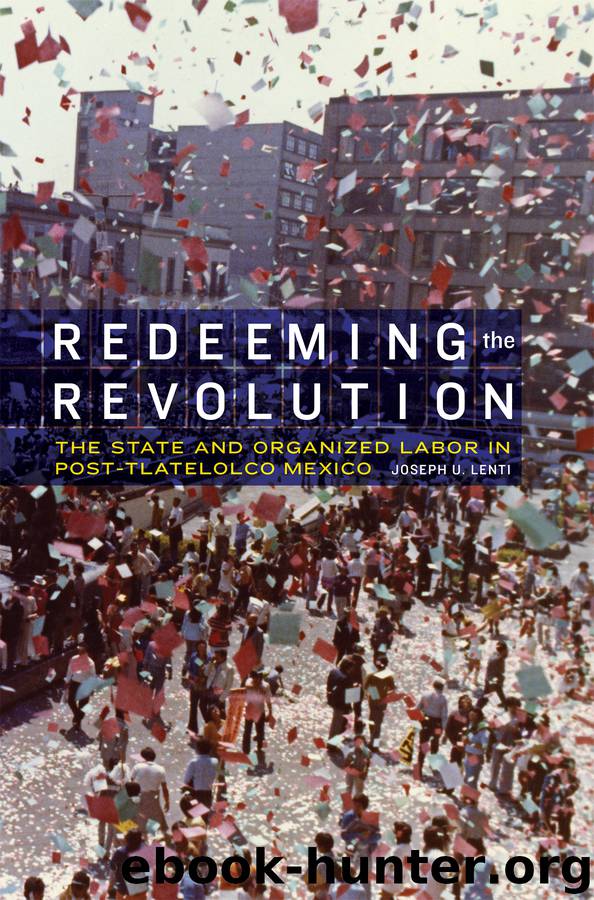Redeeming the Revolution by Joseph U. Lenti

Author:Joseph U. Lenti [Lenti, Joseph U.]
Language: eng
Format: epub
Tags: HIS025000 History / Latin America / Mexico
ISBN: 978-1-4962-0133-1
Publisher: University of Nebraska Press
Published: 2017-06-08T16:00:00+00:00
The Collective Contract
Organized labor’s post-Tlatelolco desire to drape labor-capital relations with a banner of social justice is most evident in the language of the collective contracts established in the period. Collective labor contracts were legal agreements reached between a designated group of workers organized into a union and the ownership of a single company or multiple companies that employed said workers. The document was produced via negotiations held between labor and corporate representatives and was organized into three distinct sections: (a) the cover (envoltura)—which related the conditions that spawned the birth of the contract and outlined clauses relative to the its duration, modification, and termination; (b) the regulator (normativo)—which listed the names and residences of all titulares (designated representatives of the contractual entities) and specified the conditions of work, including salaries, work schedules, holidays and vacations, required safety measures, and terms of social programs, among many other items; and (c) the obligatory element (elemento obligatorio)—which stated the measures available to enforce compliance of the terms fixed in the regulator.9 Union representatives and management drafted the terms of the contract, but it was subjected to scrutiny by state and federal labor authorities before enactment. With government certification the contract acquired full legal authority to dictate labor-capital relations between the listed contractees for a period established in the document, typically two years.
Very little in the NLFT’s language that established the collective contract, however, indicated a bias for workers over owners. The rights to modify, suspend, and terminate collective labor relations were guaranteed to owners and workers alike in Chapters VI, VII, and VIII, respectively. The collective contract was defined similarly in the 1970 and 1931 codes, yet there were some important differences. Article 42 of the 1931 Federal Labor Law and Article 386 of the NLFT mutually defined the collective contract as an “agreement reached between one or several trade unions and one or several employers, or one or several unions of employers, toward the end of establishing the conditions by which labor must be lent,” though the latter code clarified that it would regulate relations “in one or more businesses or establishments.”10 Follow-up articles showed variations that were more interesting. Article 43 in the 1931 code explained that “any employer that employs workers belonging to a union will have the obligation of reaching a collective contract with that union when it solicits it.”11 Article 387 of the NLFT reproduced the language but included an addendum giving workers near carte blanche to exercise the right to strike as consigned in Article 450 of the current law.
Clearly significant, the additional language suggested that labor law in the post-1970 period would have an action-friendly bent. Article 426 of the NLFT specified that unions and owners would henceforth be able to solicit conciliation and arbitration boards to modify labor terms set in collective contracts when either (a) economic conditions existed that justified it or (b) an increase in the cost of living provoked an imbalance between capital and labor.12 No similar language was found in the guidelines set for modifying collective contracts in the 1931 statute.
Download
This site does not store any files on its server. We only index and link to content provided by other sites. Please contact the content providers to delete copyright contents if any and email us, we'll remove relevant links or contents immediately.
| Arms Control | Diplomacy |
| Security | Trades & Tariffs |
| Treaties | African |
| Asian | Australian & Oceanian |
| Canadian | Caribbean & Latin American |
| European | Middle Eastern |
| Russian & Former Soviet Union |
The Secret History by Donna Tartt(18951)
The Social Justice Warrior Handbook by Lisa De Pasquale(12170)
Thirteen Reasons Why by Jay Asher(8848)
This Is How You Lose Her by Junot Diaz(6837)
Weapons of Math Destruction by Cathy O'Neil(6220)
Zero to One by Peter Thiel(5736)
Beartown by Fredrik Backman(5682)
The Myth of the Strong Leader by Archie Brown(5461)
The Fire Next Time by James Baldwin(5386)
How Democracies Die by Steven Levitsky & Daniel Ziblatt(5175)
Promise Me, Dad by Joe Biden(5117)
Stone's Rules by Roger Stone(5053)
A Higher Loyalty: Truth, Lies, and Leadership by James Comey(4909)
100 Deadly Skills by Clint Emerson(4882)
Rise and Kill First by Ronen Bergman(4741)
Secrecy World by Jake Bernstein(4703)
The David Icke Guide to the Global Conspiracy (and how to end it) by David Icke(4658)
The Farm by Tom Rob Smith(4468)
The Doomsday Machine by Daniel Ellsberg(4452)
